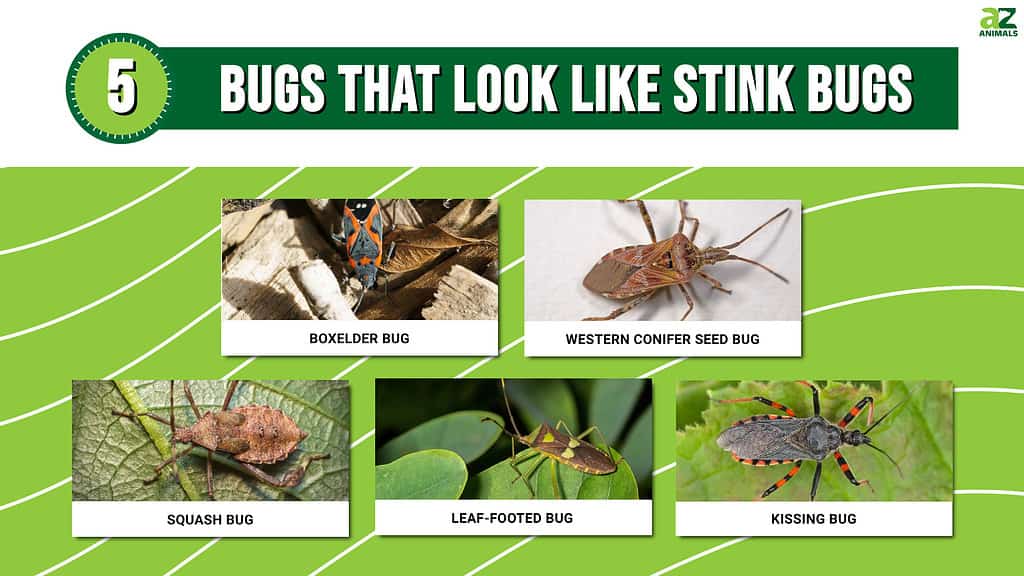
You’d probably think nothing compares to the sight of stink bugs, right? These little critters are known for their unpleasant odor and trademark shield-shaped bodies. But despite their deceptive appearance, several other bugs look like stink bugs.
This article will discuss some potential stink bug imposters — including one that is actually dangerous. We believe that by the end, you’ll better understand the differences between stink bugs and their look-alikes. Let’s get started!
What Is a Stink Bug?

Stink bugs are known for their foul-smelling odor.
©Jay Ondreicka/Shutterstock.com
Stink bugs are part of the true bug order, Hemiptera, in the family Pentatomidae. These bugs are known for their foul-smelling odor — hence their name, and they emit this odor as a defense mechanism against predators.
The brown marmorated stink bug, Halyomorpha halys, referred to in this article, is among the most common stink bug species in North America. With a shield-shaped body, it is an invasive insect native to East Asia. This pest was first reported in the United States in the late ’90s. Since then, brown marmorated stink bugs have spread across the Eastern United States, which is now a major agricultural pest.
This species is an herbivorous pest, feeding on various plant species, including fruits, vegetables, and even ornamental plants. The brown marmorated stink bug has a mottled, shield-shaped body with alternating light and dark bands on its antennae.
Other stink bug species you might encounter in North America are:
- One-spotted stink bug, known as Euschistus variolarius
- Green stink bug, known as Chinavia hilaris
- Red-shouldered stink bug, known as Thyanta custator
- Brown stink bug, known as Euschistus servus
Common Bugs That Look Like Stink Bugs
Stink bugs are recognizable because of their appearance, but several other types of bugs closely resemble them. While most are harmless to humans, some may have painful bites or even be dangerous. Below is a rundown of stink bugs’ look-alikes.
1. Boxelder Bugs
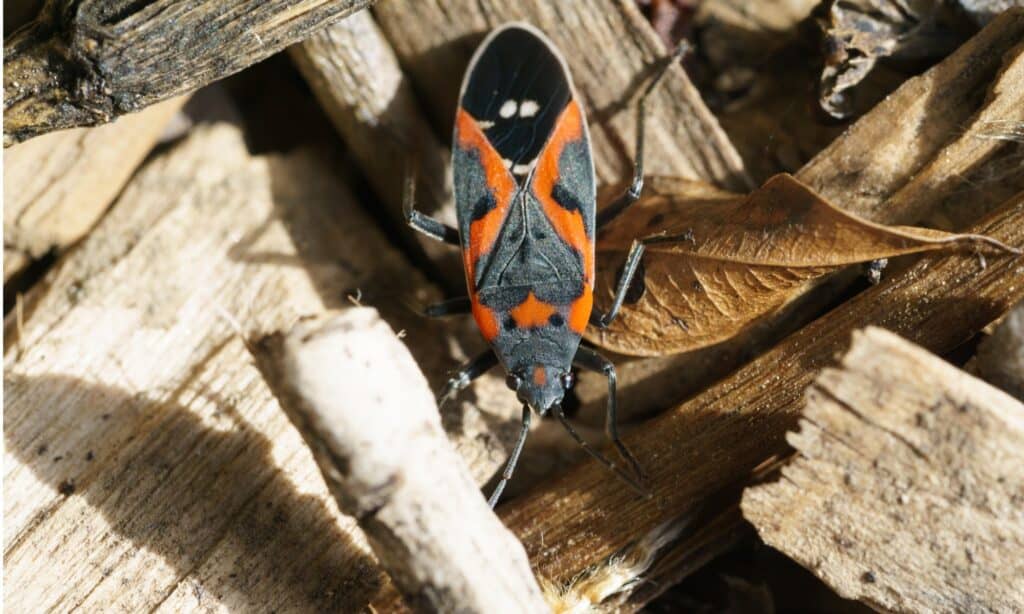
Boxelder bugs have flattened oval-shaped bodies with tapering at the end.
©iStock.com/fusaromike
Boxelder bugs are very similar to stink bugs in behavior and peskiness. Like stink bugs, boxelder bugs are attracted to warm surfaces, which is why you may find them congregated on the walls during colder months. They aren’t dangerous to humans or pets directly. However, they do have the potential to damage plants as they feed on the sap of deciduous trees like maple and box elder. If disturbed, these bugs secrete a dye that stains and leaves an unpleasant, musty odor — like stink bugs. So how do you tell if it’s a boxelder or a stink bug?
Interestingly, you can tell the two bugs apart by their color and shape. Boxelder bugs have flattened oval-shaped bodies with tapering at the end. They can be either black or brown, with red-orangish markings on their bodies. They are slightly smaller, reaching only around 0.51 inches long. Conversely, stink bugs are a bit longer, and their bodies are wider. They are typically brown with cream, gray, or black markings. Their stink glands, which secrete the foul-smelling odor, are on the underside between the first two pairs of legs.
2. Western Conifer Seed Bug
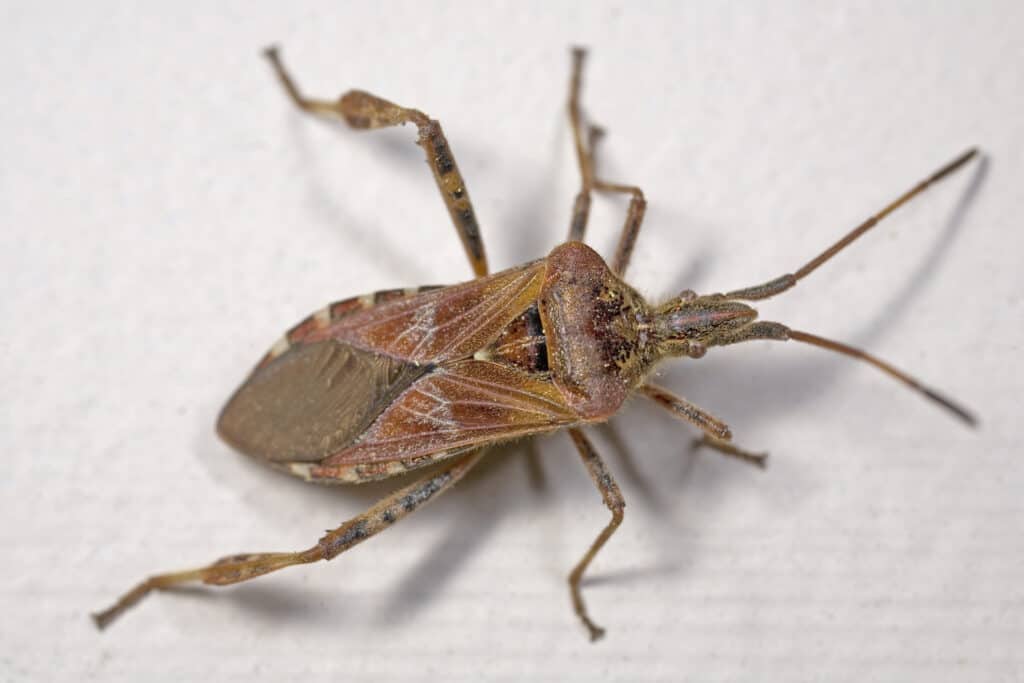
Western conifer seed bugs have pale white zig-zag stripes under their wings.
©iStock.com/jscalev
Western conifer seed bugs are known for the unpleasant smell they emit when disturbed, just as stink bugs do. Another reason you will mistakenly call the western conifer seed bug a stink bug is that these two species have similar behaviors. They are both active in early spring and may congregate around your home looking for a place to overwinter. Once they find a crack or a potential opening, they will attempt to squeeze through.
Another shared trait is that both species are harmless to humans, meaning they don’t bite or sting. However, despite these similarities, there’s a way to tell the two bugs apart. Western conifer seed bugs have distinctive widened hind legs that give them a “leaf-like” shape. This helps differentiate it from the more symmetrical shield-shaped stink bugs. Besides the light brown shades on their wings, western conifer seed bugs also have pale white zig-zag stripes under their wings.
3. Squash Bug
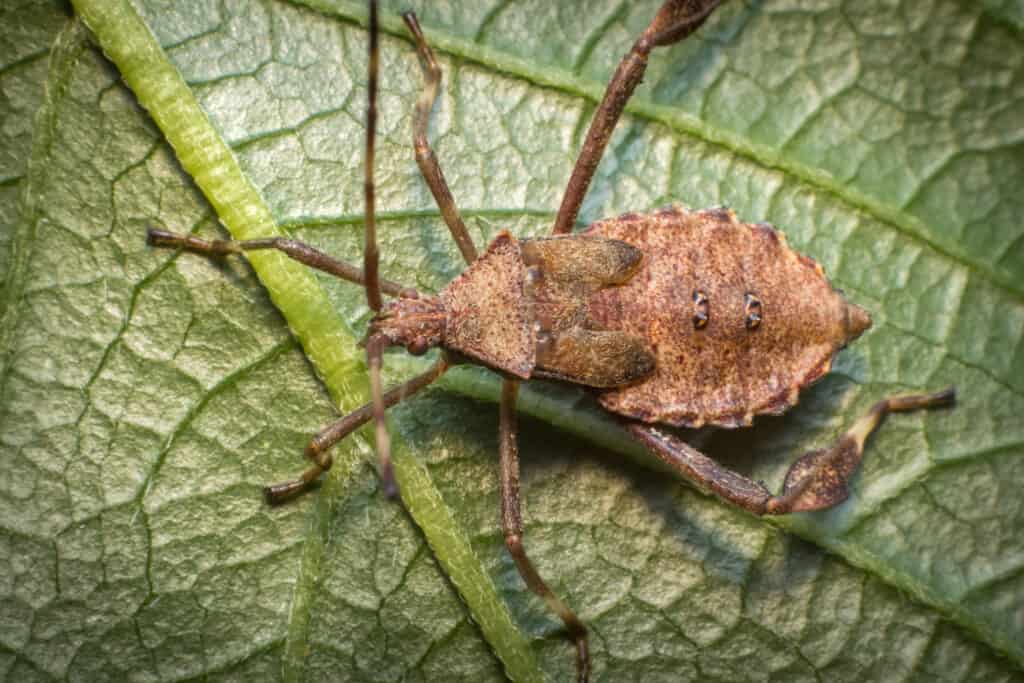
Squash bugs are mostly found in gardens, vegetable patches, and other places where squash or pumpkins are grown.
©iStock.com/EzumeImages
People will often mistake a squash bug for a stink bug. They share some similarities in feeding behavior, and to some extent, they look similar. Both species are covered by hard, shield-like shells, emitting a foul odor when disturbed. Squash bugs can also be mistaken for stink bugs because of their coloration. While they can have various colors, including yellow or green, most squash bugs are brown or gray, just like stink bugs.
Like a stink bug, a squash bug is wide-bodied. It also has similar pairs of legs. Even its antennae have similar coloration. However, despite their similarities, you can distinguish the two by their body shape. Squash bugs have a more elongated body, making them appear narrower.
Stink bugs may appear larger than squash bugs because of their wider bodies. Their length also differs slightly, with stink bugs being slightly longer. However, to the untrained eye, distinguishing these two through the size of their bodies may be difficult, especially since their body length highly depends on their age and environment.
Without looking at their physical traits, you can quickly identify the two species from where you find them. Squash bugs are mostly found in gardens, vegetable patches, and other places where squash or pumpkins are grown. They feed on these plants’ leaves, vines, and juices and lay their eggs at the base of their stems. In comparison, stink bugs will feed on fruits, tomatoes, and other vegetables. They don’t rely on a single species of vegetables.
4. Leaf-Footed Bug
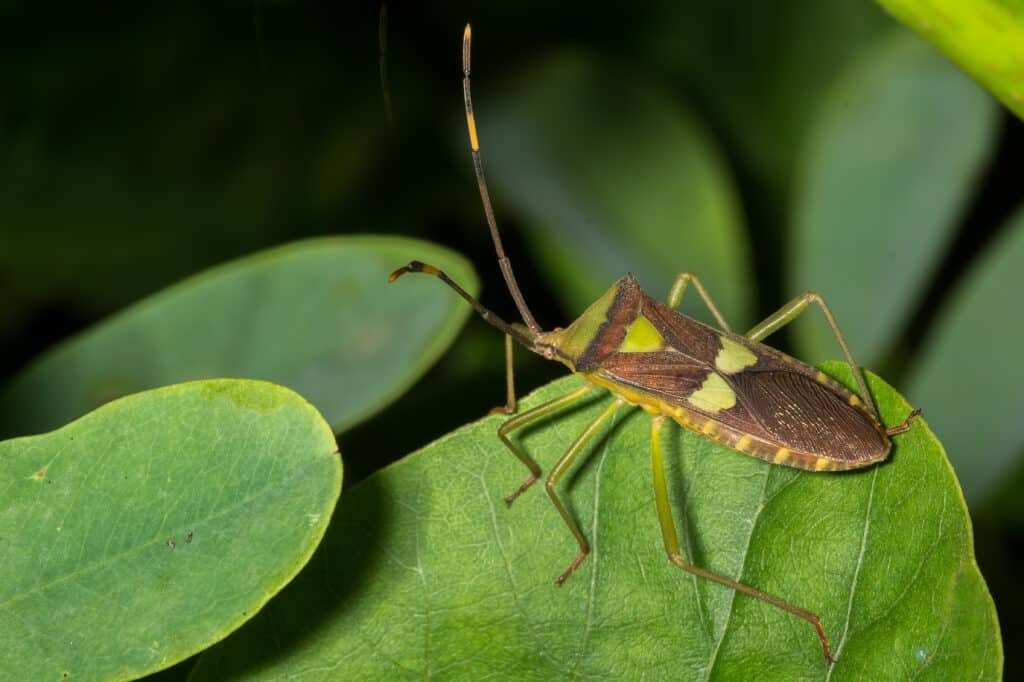
Leaf-footed bugs are part of the
Hemipteraorder.
©Sanjay M Dalvi/Shutterstock.com
Leaf-footed bugs are often confused with stink bugs because they are also part of the Hemiptera order. These two bugs have similar life cycles. Both species also share the same behavior of overwintering as adults, often found in weedy areas, leaf litter, and under the bark of trees. Another similarity these two species have is that they feed with piercing-sucking mouthparts. Moreover, as adults, these bugs can damage almond trees.
However, it is possible to tell them apart by looking at their legs. Leaf-footed bugs have enlarged bowed hind legs that resemble leaf-like flaps. Besides, they are larger, more oval-shaped, and much narrower than stink bugs. Leaf-footed bugs can also be distinguished from stink bugs through the horizontal zig-zag pattern across their backs.
5. Kissing Bug
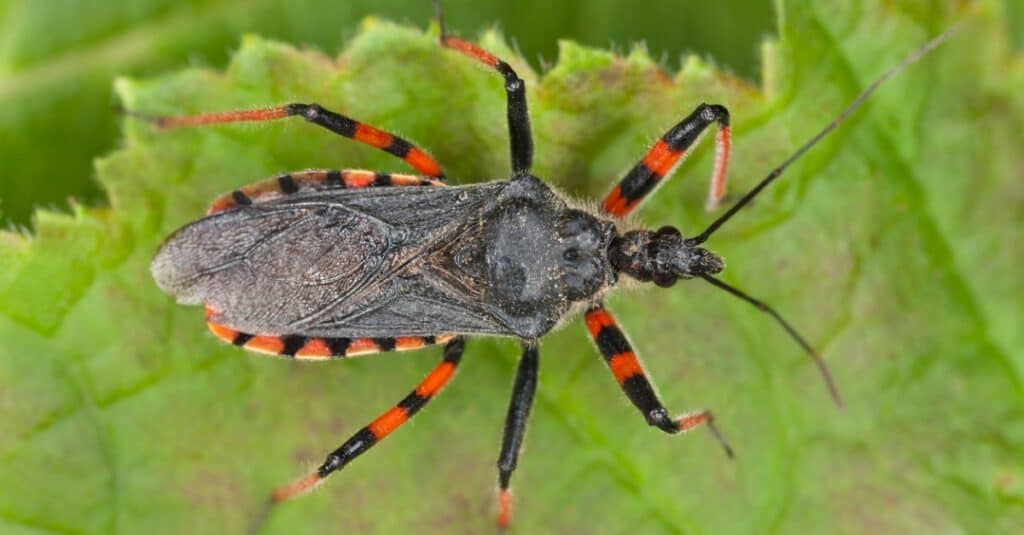
Kissing bugs have dark brown or black wings with orange, red, or yellow stripes around the edges.
©Henrik Larsson/Shutterstock.com
Kissing bugs, also known as Triatominae or vampire bugs, look the most like sting bugs. They get their name because they bite humans around their mouths. Though their bites aren’t usually painful, kissing bugs can transmit Chagas disease. This potentially deadly disease is caused by a parasite the bug carries and is transmitted to humans through bites. It can also spread through foods or drinks contaminated with kissing bugs or feces.
Kissing bugs are often mistaken for stink bugs because of their similar size and color. Both bugs have brown-to-black coloring and lighter markings along the edges of their body. Moreover, both bugs have three pairs of legs.
You can distinguish kissing bugs from stink bugs by checking their antennae. Unlike stink bugs, kissing bugs have longer and more slender antennae that point straight outward. The body shape is different, too. Kissing bugs have cone-shaped, slender bodies, while stink bugs have shield-shaped heads and bodies. Size-wise, adult stink bugs are approximately 0.67 inches long, while adult kissing bugs can reach up to an inch long.
Kissing bugs have dark brown or black wings with orange, red, or yellow stripes around the edges. In contrast, stink bugs have light brown wings, which lack the bright stripes found on a kissing bug’s wings. The biggest difference between these bugs is that stink bugs don’t bite while kissing bugs do.
Summary of Five Bugs That Look Like Stink Bugs
| Rank | Bug |
|---|---|
| 1 | Boxelder Bugs |
| 2 | Western Conifer Seed Bug |
| 3 | Squash Bug |
| 4 | Leaf-Footed Bug |
| 5 | Kissing Bug |
The photo featured at the top of this post is © iStock.com/ErikAgar
Sources
- Wilbur-Ellis Agribusiness, Available here: https://www.wilburellisagribusiness.com/a-true-problem-stink-bug-leaf-footed-plant-bug/
- Insect Cop, Available here: https://insectcop.net/bugs-that-look-like-stink-bugs/#
- StopBMSB, Available here: https://www.stopbmsb.org/stink-bug-basics/look-alike-insects/
- Modern Pest Services, Available here: https://www.modernpest.com/blog/stink-bug-western-conifer-seed-bug-house/
Thank you for reading! Have some feedback for us? Contact the AZ Animals editorial team.






